Osmundastrum
Osmundastrum is genus of leptosporangiate ferns in the family Osmundaceae with one accepted species, Osmundastrum cinnamomeum, the cinnamon fern. It is native to the Americas and eastern Asia, growing in swamps, bogs and moist woodlands.
| Osmundastrum | |
|---|---|
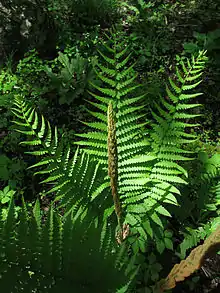 | |
| Developing spore-bearing frond and several sterile fronds in late spring | |
| Scientific classification | |
| Kingdom: | Plantae |
| Clade: | Tracheophytes |
| Class: | Polypodiopsida |
| Order: | Osmundales |
| Family: | Osmundaceae |
| Genus: | Osmundastrum C.Presl |
| Species: | O. cinnamomeum |
| Binomial name | |
| Osmundastrum cinnamomeum (L.) C.Presl | |
| Synonyms | |
|
Osmunda cinnamomea L. | |
In North America it occurs from southern Labrador west to Ontario, and south through the eastern United States to eastern Mexico and the West Indies; in South America it occurs west to Peru and south to Paraguay. In Asia it occurs from southeastern Siberia south through Japan, Korea, China and Taiwan to Myanmar, Thailand and Vietnam.
Characteristics
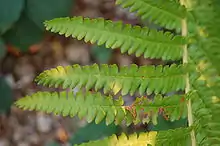
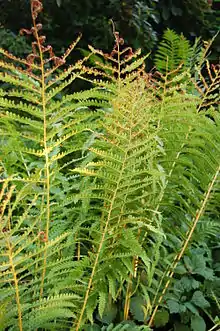
Osmundastrum cinnamomeum is a deciduous herbaceous plant that produces separate fertile and sterile fronds. The sterile fronds are spreading, 30–150 cm (0.98–4.92 ft) tall and 15–20 cm (5.9–7.9 in) broad, pinnate, with pinnae 5–10 cm (2.0–3.9 in) long and 2–2.5 cm (0.79–0.98 in) broad, deeply lobed (so the fronds are nearly, but not quite, bipinnate). The fertile spore-bearing fronds are erect and shorter, 20–45 cm (7.9–17.7 in) tall; they become cinnamon-colored, which gives the species its name. The fertile leaves appear first; their green color slowly becomes brown as the season progresses and the spores are dropped. The spore-bearing stems persist after the sterile fronds are killed by frost, until the next season. The spores must develop within a few weeks or fail.
The Osmundastrum cinnamomeum fern forms huge clonal colonies in swampy areas. These ferns form massive rootstocks with densely matted, wiry roots. This root mass is an excellent substrate for many epiphytal plants. They are often harvested as osmunda fiber and used horticulturally, especially in propagating and growing orchids. Cinnamon Ferns do not actually produce cinnamon; they are named for the color of the fertile fronds.
Classification
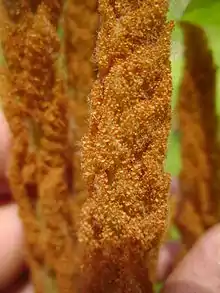
Traditionally, this plant has been classified as Osmunda cinnamomea L. However, recent genetic and morphological evidence (Metzgar et al. 2008; Jud et al. 2008) clearly demonstrate that the cinnamon fern is a sister species to the entire rest of the living Osmundaceae. Cladistically, it is either necessary then to include all species of the Osmundaceae, including Todea and Leptopteris in the genus Osmunda, or else it is necessary to segregate the genus Osmundastrum. O. cinnamomeum is the sole living species in the genus,[2] although it is possible that some additional fossils should be assigned to Osmundastrum.[3]
Formerly, some authors included the interrupted fern, Osmunda claytoniana, in the genus or section Osmundastrum, because of its gross apparent morphological similarities. However, detailed morphology and genetic analysis have proven that the interrupted fern is actually a true Osmunda. This is borne out by the fact that it is known to hybridize with the American royal fern, Osmunda spectabilis to produce Osmunda × ruggii in a family in which hybrids are rare, while Osmundastrum cinnamomeum has no known hybrids.
Osmundastrum cinnamomeum is considered a living fossil because it has been identified in the geologic record as far back as 75 million years ago.[3] A more recent discovery extends this value up to 180 million years ago.[4]
The Asian and American populations of cinnamon fern are generally considered to be varieties of a single species, but some botanists classify them as separate species.[2] The Asian taxon is thus named Osmundastrum asiaticum.
Uses
According to the Native American Ethnobotany Database, cinnamon fern has been historically used by first nations tribes (Abnaki, Menominee) as a food source. The Iroquois and Cherokee tribes used the fern for a wide variety of medicinal purposes including as a cold remedy, gynecological aid, venereal aid, and as a remedy to snake bites.
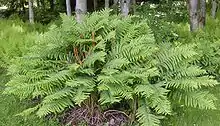
References
- "NatureServe Explorer 2.0 - Osmunda cinnamomea Cinnamon Fern". explorer.natureserve.org. Retrieved 9 October 2020.
- Alan S. Weakley (April 2008). "Flora of the Carolinas, Virginia, and Georgia, and Surrounding Areas".
- Jud, Nathan, Gar W. Rothwell, and Ruth A. Stockey (2008). "Todea from the Lower Cretaceous of western North America: implications for the phylogeny, systematics, and evolution of modern Osmundaceae". American Journal of Botany. 95 (3): 330–339. doi:10.3732/ajb.95.3.330. PMID 21632358.CS1 maint: multiple names: authors list (link)
- "Lava fossilised this Jurassic fern down to its cells". New Scientist. Retrieved 2017-02-13.
Further reading
- Metzgar, Jordan S., Judith E. Skog, Elizabeth A. Zimmer, and Kathleen M. Pryer (2008). "The Paraphyly of Osmunda is Confirmed by Phylogenetic Analyses of Seven Plastid Loci." Systematic Botany, 33(1): pp. 31–36.
- Serbet, Rudolf, and Gar W. Rothwell (1999). "Osmunda cinnamomea (Osmundaceae) in the Upper Cretaceous of western North America: Additional evidence for exceptional species longevity among filicalean ferns." International Journal of Plant Sciences, 160: 425–433.
External links
- USDA Plants treatment: Osmundastrum cinnamomeum (Cinnamon fern)
- Flora of North America: Flora of North America treatment: Osmunda cinnamomea
- Flora of North America: RangeMap: Osmunda cinnamomea
- "Osmunda cinnamomea". Integrated Taxonomic Information System.
- "Osmunda cinnamomea". Germplasm Resources Information Network (GRIN). Agricultural Research Service (ARS), United States Department of Agriculture (USDA).
- Flora of Taiwan: Osmunda cinnamomea
- Rook.org - Cinnamon fern description & photo
| Wikimedia Commons has media related to Osmundastrum cinnamomeum. |
